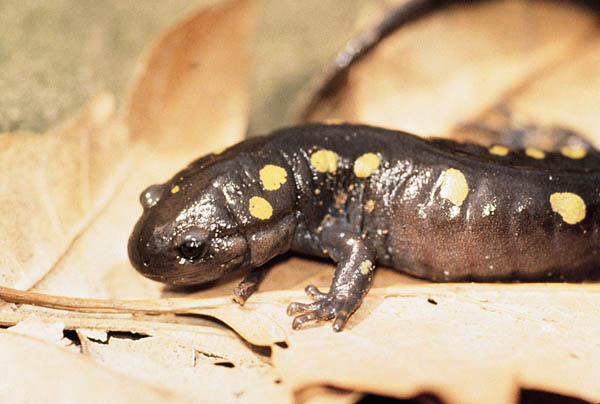 Early spring is a favorite time for amphibian enthusiasts. Here in the northeastern USA, a spectacular event is unfolding, as Wood Frogs, Tiger and Spotted Salamanders, Spring Peepers and others head en masse for their breeding ponds. I’ve been visiting one pond, first shown to me by herpetologist John Behler, for nearly 30 years. When luck is with me, I can see 3 amphibian species, along with fairy shrimp and other interesting creatures, in a single evening (please see article below).
Early spring is a favorite time for amphibian enthusiasts. Here in the northeastern USA, a spectacular event is unfolding, as Wood Frogs, Tiger and Spotted Salamanders, Spring Peepers and others head en masse for their breeding ponds. I’ve been visiting one pond, first shown to me by herpetologist John Behler, for nearly 30 years. When luck is with me, I can see 3 amphibian species, along with fairy shrimp and other interesting creatures, in a single evening (please see article below).
The small vernal (temporary) pools used by many amphibians are fragile habitats, and quickly spoiled by pollutants; that many are near roads worsens the situation. With their highly-permeable skins, amphibians are especially sensitive to changes in water quality. The recent finding that Spotted Salamanders (Ambystoma maculatum) may be evolving defenses against roadside toxins is a rare light at the end of the rather dismal “amphibian conservation” tunnel.
“Salt Water” Salamanders
Yale University researchers report (Science Papers, January, 2012) that toxins carried into ponds via road runoff may be spurring the rapid evolution of defensive adaptations in Spotted Salamanders. Due to road salting, the salinity of roadside ponds can be 70 times that of nearby woodland ponds; a variety of other toxins are also commonly present.
Life in ponds subjected to road runoff is difficult. Salamander larvae living in roadside ponds suffer higher mortality (44% vs. 13%) and an increased number of skeletal defects than do larvae from ponds located away from roads. Also, metamorphosis is delayed. This is particularly troublesome, as vernal pools dry up during the summer – larvae that have not transformed by that time perish.
Only the Strong Survive…
However, those salamanders that have somehow adapted to these harsh conditions seem to gain a survival advantage over those hailing from “natural”, or un-polluted, ponds. Their larvae out-survive other larvae when both are reared together in roadside water.
 More surprising than this, however, is the fact that roadside pond larvae also do better than natural pond larvae when reared in unpolluted water. The mechanics are not yet understood, but some survival advantage seems to carry over and remain useful even in non-toxic environments.
More surprising than this, however, is the fact that roadside pond larvae also do better than natural pond larvae when reared in unpolluted water. The mechanics are not yet understood, but some survival advantage seems to carry over and remain useful even in non-toxic environments.
This finding is the first known example of a vertebrate evolving in response to roadside toxins. However, only cautious optimism is in order, as each environment and species represents a different scenario…and far more creatures are likely to succumb rather than adapt to pollution.
Further Reading
Vernal Pond Ecology (great photos)
Full text of the Science Papers article mentioned above
Spotted Salamander Natural History
Wood Frog image referenced from wikipedia and originally posted by D Gordon E Robertson
 That Reptile Blog – Reptile, Amphibian and Exotic Pet Care and Information
That Reptile Blog – Reptile, Amphibian and Exotic Pet Care and Information



Hi again Frank. This is a fantastic post. It often astounds me that mother nature still has the ability to ‘find a way’. As you say, light at the end of a dismal tunnel indeed.
As you know, it’s the animals in fresh water that are dying out the fastest world wide, as pollution and ‘development’ take their toll.
I’m really curious about this and hope you can find the time to do a follow up down the track ~
again, many thanks for posting.
Paul.
Hello Paul,
Thanks for the kind words, nice to hear from you again. I’m going out tonight to check a salamander breeding pond; I’ll follow up with any new developments on this post.
Good luck, enjoy and please keep me posted.
Best regards, Frank Indiviglio.
Not sure if I showed you this but seeing all those kid videos here is a video of a neat find of my own.
http://www.youtube.com/watch?v=5Cse8HwzGoo&context=C4d5db7bADvjVQa1PpcFOTioYe4OqZuAV40sowbhn6QQ21bAcDrfY=
Hello Joseph,
Very nice video, thanks so much! Interesting to see the breeding habitat; I’ve only found them on land in CA, and I think many will be surprised that they use such fast flowing waters. Happy herping,
Best regards, Frank Indiviglio.